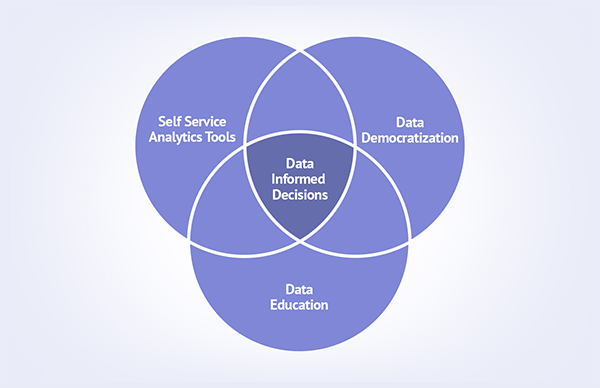Although data science and data analysis are two different fields, they are both essential for organizations to run in the market.
While data science involves the study of data for gaining business insights, data analysis involves the process of data collection and conversion.
This allows the decision-makers to use the gathered information as per their requirements to understand the market and take measures accordingly.
You can also pursue the course from MIT Data Science and master the art of gaining insights into the same.
The integration of artificial intelligence and machine learning can help improve the process of decision-making.
Curious how it will shape the future of data-driven decision-making? Then stick till the end to find your answers. So, let’s get started!

Making informed decisions is crucial for every organization to gain a more comprehensive perspective on the market trends and their operational performance.
It is a systematic process that involves obtaining the appropriate documentation and analyzing it to decide which course of action is the best.
This is why this approach plays a critical role in both contexts: personal and professional; it enables organizations to make decisions with the evidence. Thus, data-driven decision-making is a practical concept that guides business-oriented action with the help of data analysis and data science.
Its fundamental principle is to replace intuitions with evidence-based insights, which eliminates the margin of error and increases the chances of positive outcomes. So, learn about the vital steps that are involved in the process of data-driven decision-making:
By following these steps, you will be able to make wise and smart decisions that can streamline the whole results.
DID YOU KNOW?
According to the annual research survey conducted by McKinsey, the reports indicate that investments in AI have doubled by 50%-60% since 2017!

With 33% of the industries associated with technology and service providers planning to invest more than $1 million in technologies, they became a big shot.
Artificial Intelligence and Machine Learning have been used to streamline the organization, which has resulted in the development of the technology called decision intelligence (DI). You can also enroll yourself in AI and ML courses, to learn about its functioning.
Listed below are the roles that it plays in the procedure of data-driven decision-making:

Having optimized predictive analytics is crucial and has proven from time to time how it transforms any organization’s market dynamics and future scenarios.
The development of decision intelligence (DI) with the help of these technologies can continue to significantly sift through the endless amount of datasets. This reduces the time taken to analyze the data, unlike the traditional analysis method.
So instead of focusing on the historical aspect of the data, it focuses on providing you with a predictive lens on the:
With foresight, the organizations can work on the decision-making process and unlock an efficient strategy that can drastically improve the operational levels.

To get a unified view of the landscape of any organization, integrate data from the internal and external databases.
Collaborating these datasets into a cohesive framework provides you with a much more comprehensive analysis, which breaks down the walls between the various departments. In this manner, you are provided with a holistic understanding of the:
These are crucial to understanding and identifying the existing correlations and weak points that may have been missed out on for various reasons.
So. integrating AI and ML further into the system can help empower organizations by navigating them through the complexity of the modern-day market and businesses.

With the integration of the technology to utilize the vast datasets that could be personal, adhering to ethical standards is a must. Practicing this also involves the implementation of clear policies on:
Not only does it help in building good relations between two companies and stakeholders, but it also helps in avoiding biases that could lead to adverse outcomes.
This helps in prioritizing the ethical considerations that organizations should be complying with such regulations to build a positive image. It will also help in strengthening the relations with their customers.
Thus, fostering these technologies can help businesses achieve their goals more sustainably and responsibly.

To promote accessibility and comprehensibility of the datasets, democratizing data across all levels of organizations is crucial. It challenges the traditional filtration of the data analysis and decision-making since it could be inaccurate as well.
This encourages an inclusive environment that allows you to share the inputs, insights, and information more openly to gain more perspectives on the same.
Now the employees at different levels can contribute to the decision-making process which fosters a culture of collaboration and collectivizes intelligence.
Thus, it can be said that this shift has been promoting a sense of accountability, unity, and productivity among the team members.
Making decisions based on data can be quite a task since they are gathered on a large scale, which makes storing and analyzing it harder.
However, integrating artificial intelligence and machine learning can level up your decision-making process efficiently.
With the help of these technologies, you can now focus on data governance and quality without any worries since its analytical tools are at the top of their game. They can significantly cut down on your costs and streamline efficiency.
Also Read: Elevate Your Career With Data-Driven Business Analytics

Thanks for choosing to leave a comment. Please keep in mind that all comments are moderated according to our comment Policy.